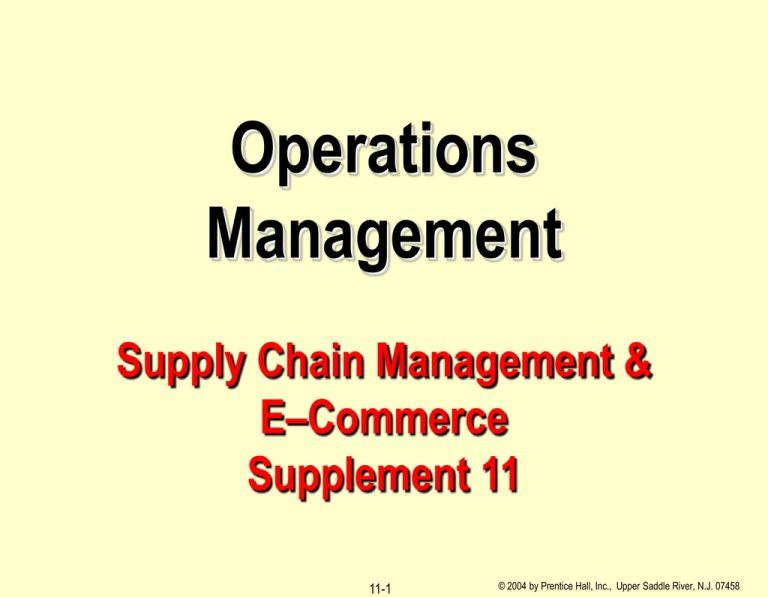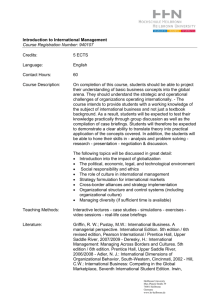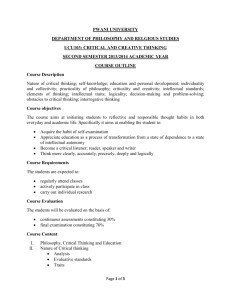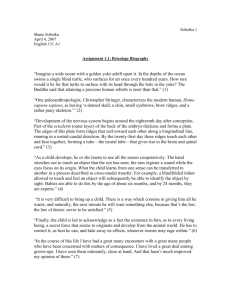SCM & E-Commerce
advertisement

Operations Management Supply Chain Management & E–Commerce Supplement 11 11-1 © 2004 by Prentice Hall, Inc., Upper Saddle River, N.J. 07458 Supply Chain Management Planning, organizing, directing, and controlling flows of materials Raw materials through internal operations through distribution of finished goods to customers Associated information flows Associated cash flows Involves everyone in the supply chain – e.g. your supplier’s supplier Objective: maximize value & lower waste Most firms spend over 50% of their sales on purchases 11-2 © 2004 by Prentice Hall, Inc., Upper Saddle River, N.J. 07458 Supply Chain Performance Typical Firms Administrative costs as percent of purchases Benchmark Firms 3.3% 0.8% Lead time (weeks) 15 weeks 8 weeks Time spent in placing order 42 minutes 15 minutes Percentage of late deliveries 33% 2% Percentage of rejected material 1.5% .0001% Number of shortages per year 400 11-3 4 © 2004 by Prentice Hall, Inc., Upper Saddle River, N.J. 07458 The Supply Chain Material Flow Supplier Credit Flow VISA ® Manufacturing Supplier Schedules Retailer Consumer Wholesaler Retailer Order Flow 11-4 Schedules Cash Flow $ © 2004 by Prentice Hall, Inc., Upper Saddle River, N.J. 07458 Managing the Customer Interface Order placement process Activities required to register the need for a product or service and to confirm the acceptance of the order Order fulfillment process Activities required to deliver a product or service to a customer 11-5 © 2004 by Prentice Hall, Inc., Upper Saddle River, N.J. 07458 Managing the Supplier Interface Supplier selection and certification Supplier relations E–commerce 11-6 © 2004 by Prentice Hall, Inc., Upper Saddle River, N.J. 07458 Make vs. Buy Reasons for Making Maintain core competencies Protect proprietary design or process Obtain a unique / not-readily available item Assure adequate supply Obtain desired quantity Lower production cost Unsuitable suppliers Remove supplier collusion Increase or maintain size of company / utilize surplus labor / avoid layoffs 11-7 © 2004 by Prentice Hall, Inc., Upper Saddle River, N.J. 07458 Make vs. Buy Reasons for Buying Frees management to deal with its primary business Inadequate managerial or technical resources Item is protected by patent or trade secret Inadequate capacity Lower acquisition cost Reduce inventory costs Ensure flexibility and alternate source of supply Preserve supplier commitment Reciprocity 11-8 © 2004 by Prentice Hall, Inc., Upper Saddle River, N.J. 07458 Vendor Evaluation 11-9 © 2004 by Prentice Hall, Inc., Upper Saddle River, N.J. 07458 Supplier Strategies Multiple Source Single Source Many sources per item Arm’s-length relationship Short-term Little openness Negotiated, sporadic PO’s Infrequent, large lots Delivery to receiving dock Cost – business to low bidder 11-10 One / few sources per item Partnership (JIT) Long-term, stable Audits, visits, shared work Exclusive contracts Frequent, small lots Delivery to point of use Cost – create value with large orders, learning curve © 2004 by Prentice Hall, Inc., Upper Saddle River, N.J. 07458 Daimler Chrysler’s Supplier Cost Reduction Effort Supplier Suggestion Model Savings Rockwell Use passenger car door locks on trucks Simplify design/substitute materials on manual window system Change tooling for woodgrain panels to allow three from one die instead of two Dodge trucks Various $280,000 Trico Change wiper-blade formulation Various $140,000 Leslie Metal Arts Exterior lighting suggestions Various $1,500,000 Rockwell 3M 11-11 Caravan, Voyager $300,000 $1,500,000 © 2004 by Prentice Hall, Inc., Upper Saddle River, N.J. 07458 Supply Chain Process Measures Order Placement Order Fulfillment Percent orders taken Percent of incomplete accurately Time to complete the order-placement process Customer satisfaction with the orderplacement process Purchasing Percent of suppliers’ orders shipped Percent of orders shipped on time Time to fulfill the order Percent of returned items or botched services Cost to produce the item or service Customer satisfaction with the order-fulfillment process 11-12 deliveries on time Suppliers’ lead times Percent defects in purchased materials and services Cost of purchased materials and services © 2004 by Prentice Hall, Inc., Upper Saddle River, N.J. 07458 Supply-Chain Environments Low Cost Competitive priorities: low cost, consistent quality and on-time delivery Predictable demand; low forecast errors Response Differentiation Competitive priorities: Competitive priorities: fast delivery times, volume flexibility, customization high-performance design quality, high development speed, customization Unpredictable demand; high forecast errors Unpredictable demand; high forecast errors Low product variety High product variety Infrequent new product introductions Low contribution Frequent new product introductions High contribution margins margins 11-13 © 2004 by Prentice Hall, Inc., Upper Saddle River, N.J. 07458 Supply Chain Design Low Cost Select suppliers for low cost Maintain high capacity utilization Minimize inventory Response Differentiation Select suppliers for Select suppliers for capacity, speed and flexibility Invest in excess capacity and flexible processes Responsive systems with throughout the chain to buffer stocks to ensure reduce cost supply Shorten lead-time as Invest aggressively to long as it does not reduce lead-time increase costs Product designs that Product designs that lead maximize performance to low set-up time and and minimize cost rapid production ramp-up 11-14 product development skills Modular processes that lend themselves to mass customization Minimize inventory in the chain to avoid obsolescence Invest aggressively to reduce development lead-time High-performance design, modular design to postpone differentiation © 2004 by Prentice Hall, Inc., Upper Saddle River, N.J. 07458 E–Commerce The use of computer networks, primarily the internet, to buy and sell products, services, and information “… all about cycle time, speed, globalization, enhanced productivity, reaching new customers and sharing knowledge across institutions for competitive advantage.” Louis Gerstner, Chairman, IBM 11-15 © 2004 by Prentice Hall, Inc., Upper Saddle River, N.J. 07458 E–Commerce Transactions Business Consumer Business Consumer B2B B2C Covisint Exchange, FreeMarket.com Amazon, Dell, Netgrocer.com C2B C2C Priceline, Travelocity eBay 11-16 © 2004 by Prentice Hall, Inc., Upper Saddle River, N.J. 07458 B2B Applications Product – drawings, specifications, video demonstrations, prices Processes – capacities, commitments, plans Transportation – carriers, lead times, costs Inventory – levels, costs, and location, tracking Supply Chain – process descriptions, performance measures, partners’ roles and responsibilities, and schedules Suppliers – product catalogue, quality history, lead times, terms, and conditions Sales / Marketing – point of sale data, promotions, pricing, discounts Customer – sales history and forecasts 11-17 © 2004 by Prentice Hall, Inc., Upper Saddle River, N.J. 07458 B2B Applications Improve development time and cost Support JIT systems Improve scheduling and logistics Reduce physical inventories Allow internet outsourcing Dramatically reduce cost Enable new business models 11-18 © 2004 by Prentice Hall, Inc., Upper Saddle River, N.J. 07458 Benefits of E–Commerce Improved, lower cost information Lower entry costs Available 24/7, virtually anywhere in the world Availability expands markets for both buyers and sellers Decreases the cost of paper-based information Reduces the cost of communication Provides richer communication than traditional means Fast delivery of digitized products Increased flexibility of location 11-19 © 2004 by Prentice Hall, Inc., Upper Saddle River, N.J. 07458 Limitations of E–Commerce Lack of system security, reliability and standards Lack of privacy Insufficient bandwidth Integrating e-commerce software with existing software is still a challenge Lack of trust in: (1) unknowns on the other end of the transaction, (2) integrity of the transaction itself, and (3) electronic money that is only bits and bytes 11-20 © 2004 by Prentice Hall, Inc., Upper Saddle River, N.J. 07458 Summary Multiple organizations are needed to create value Purchasing – Other companies Operations / Production Distribution Reengineering our order placement process and our order fulfillment process can lead to faster, better and cheaper Cooperative supplier relations can lead to faster, better and cheaper E–commerce is revolutionizing the way operations managers achieve greater efficiencies, leading to faster, better and cheaper 11-21 © 2004 by Prentice Hall, Inc., Upper Saddle River, N.J. 07458



